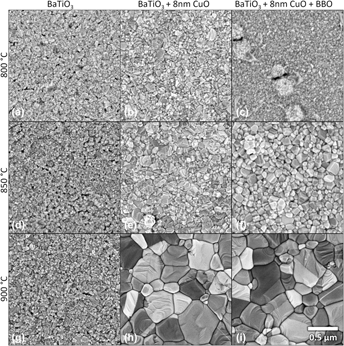Article contents
Microstructure and dielectric properties with CuO additions to liquid phase sintered BaTiO3 thin films
Published online by Cambridge University Press: 17 March 2016
Abstract

The refractory nature of BaTiO3 leads to limited densification and grain growth for films processed at low temperatures and a modest nonlinear dielectric response due to a marked sensitivity to physical scale and material quality. Adding liquid-forming sintering aids, common in bulk ceramics, to thin films enhances mass transport, leading to enhanced grain growth at lower temperatures. This work explores the effectiveness of a sputtered CuO buffer layer with BaO–B2O3 (BBO) fluxes to engineer the microstructure of BaTiO3 films. Grain size and homogeneity increase in the presence of even a ∼1 nm CuO layer. In general, grain size increases from 75 to 370 nm with an addition of 2.2% BBO and 8 nm CuO. Room temperature capacitance in fluxed films increases by a factor of 5 over pure films, and ferroelectric phase transitions are clearly observable in dielectric measurements. CuO–BBO proves effective on (0001) Al2O3 and (100) MgO substrates, although all microstructures are notably finer for the latter.
Keywords
- Type
- Articles
- Information
- Copyright
- Copyright © Materials Research Society 2016
References
REFERENCES
- 3
- Cited by


